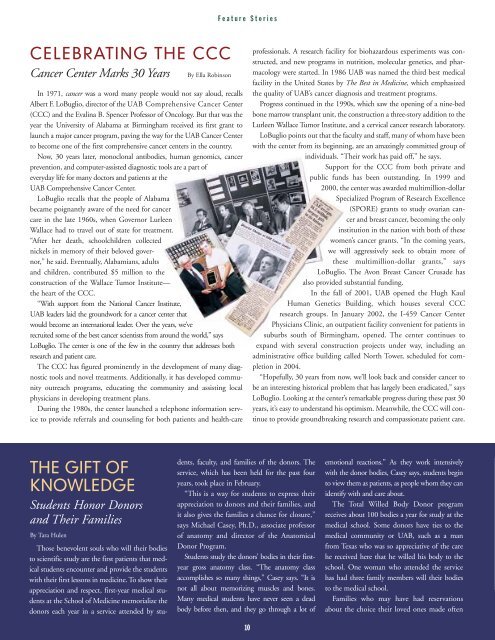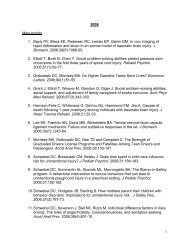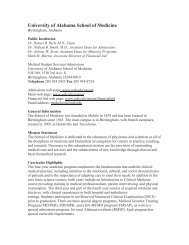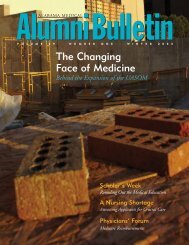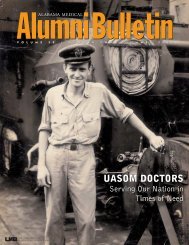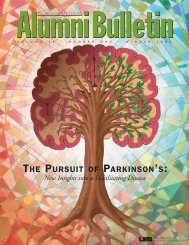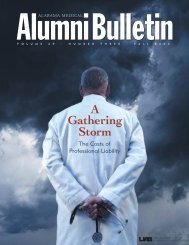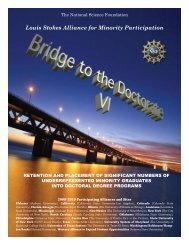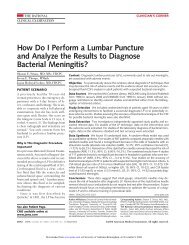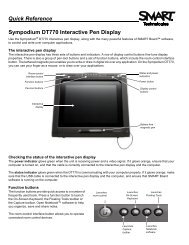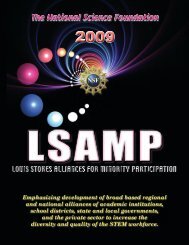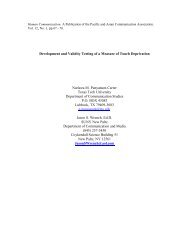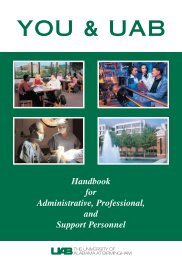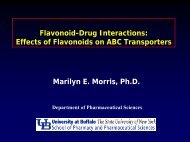In Pursuit of Precision - University of Alabama at Birmingham
In Pursuit of Precision - University of Alabama at Birmingham
In Pursuit of Precision - University of Alabama at Birmingham
You also want an ePaper? Increase the reach of your titles
YUMPU automatically turns print PDFs into web optimized ePapers that Google loves.
Fe<strong>at</strong>ure Stories<br />
CELEBRATING THE CCC<br />
Cancer Center Marks 30 Years By Ella Robinson<br />
<strong>In</strong> 1971, cancer was a word many people would not say aloud, recalls<br />
Albert F. LoBuglio, director <strong>of</strong> the UAB Comprehensive Cancer Center<br />
(CCC) and the Evalina B. Spencer Pr<strong>of</strong>essor <strong>of</strong> Oncology. But th<strong>at</strong> was the<br />
year the <strong>University</strong> <strong>of</strong> <strong>Alabama</strong> <strong>at</strong> <strong>Birmingham</strong> received its first grant to<br />
launch a major cancer program, paving the way for the UAB Cancer Center<br />
to become one <strong>of</strong> the first comprehensive cancer centers in the country.<br />
Now, 30 years l<strong>at</strong>er, monoclonal antibodies, human genomics, cancer<br />
prevention, and computer-assisted diagnostic tools are a part <strong>of</strong><br />
everyday life for many doctors and p<strong>at</strong>ients <strong>at</strong> the<br />
UAB Comprehensive Cancer Center.<br />
LoBuglio recalls th<strong>at</strong> the people <strong>of</strong> <strong>Alabama</strong><br />
became poignantly aware <strong>of</strong> the need for cancer<br />
care in the l<strong>at</strong>e 1960s, when Governor Lurleen<br />
Wallace had to travel out <strong>of</strong> st<strong>at</strong>e for tre<strong>at</strong>ment.<br />
“After her de<strong>at</strong>h, schoolchildren collected<br />
nickels in memory <strong>of</strong> their beloved governor,”<br />
he said. Eventually, Alabamians, adults<br />
and children, contributed $5 million to the<br />
construction <strong>of</strong> the Wallace Tumor <strong>In</strong>stitute—<br />
the heart <strong>of</strong> the CCC.<br />
“With support from the N<strong>at</strong>ional Cancer <strong>In</strong>stitute,<br />
UAB leaders laid the groundwork for a cancer center th<strong>at</strong><br />
would become an intern<strong>at</strong>ional leader. Over the years, we’ve<br />
recruited some <strong>of</strong> the best cancer scientists from around the world,” says<br />
LoBuglio. The center is one <strong>of</strong> the few in the country th<strong>at</strong> addresses both<br />
research and p<strong>at</strong>ient care.<br />
The CCC has figured prominently in the development <strong>of</strong> many diagnostic<br />
tools and novel tre<strong>at</strong>ments. Additionally, it has developed community<br />
outreach programs, educ<strong>at</strong>ing the community and assisting local<br />
physicians in developing tre<strong>at</strong>ment plans.<br />
During the 1980s, the center launched a telephone inform<strong>at</strong>ion service<br />
to provide referrals and counseling for both p<strong>at</strong>ients and health-care<br />
pr<strong>of</strong>essionals. A research facility for biohazardous experiments was constructed,<br />
and new programs in nutrition, molecular genetics, and pharmacology<br />
were started. <strong>In</strong> 1986 UAB was named the third best medical<br />
facility in the United St<strong>at</strong>es by The Best in Medicine, which emphasized<br />
the quality <strong>of</strong> UAB’s cancer diagnosis and tre<strong>at</strong>ment programs.<br />
Progress continued in the 1990s, which saw the opening <strong>of</strong> a nine-bed<br />
bone marrow transplant unit, the construction a three-story addition to the<br />
Lurleen Wallace Tumor <strong>In</strong>stitute, and a cervical cancer research labor<strong>at</strong>ory.<br />
LoBuglio points out th<strong>at</strong> the faculty and staff, many <strong>of</strong> whom have been<br />
with the center from its beginning, are an amazingly committed group <strong>of</strong><br />
individuals. “Their work has paid <strong>of</strong>f,” he says.<br />
Support for the CCC from both priv<strong>at</strong>e and<br />
public funds has been outstanding. <strong>In</strong> 1999 and<br />
2000, the center was awarded multimillion-dollar<br />
Specialized Program <strong>of</strong> Research Excellence<br />
(SPORE) grants to study ovarian cancer<br />
and breast cancer, becoming the only<br />
institution in the n<strong>at</strong>ion with both <strong>of</strong> these<br />
women’s cancer grants. “<strong>In</strong> the coming years,<br />
we will aggressively seek to obtain more <strong>of</strong><br />
these multimillion-dollar grants,” says<br />
LoBuglio. The Avon Breast Cancer Crusade has<br />
also provided substantial funding.<br />
<strong>In</strong> the fall <strong>of</strong> 2001, UAB opened the Hugh Kaul<br />
Human Genetics Building, which houses several CCC<br />
research groups. <strong>In</strong> January 2002, the I-459 Cancer Center<br />
Physicians Clinic, an outp<strong>at</strong>ient facility convenient for p<strong>at</strong>ients in<br />
suburbs south <strong>of</strong> <strong>Birmingham</strong>, opened. The center continues to<br />
expand with several construction projects under way, including an<br />
administr<strong>at</strong>ive <strong>of</strong>fice building called North Tower, scheduled for completion<br />
in 2004.<br />
“Hopefully, 30 years from now, we’ll look back and consider cancer to<br />
be an interesting historical problem th<strong>at</strong> has largely been eradic<strong>at</strong>ed,” says<br />
LoBuglio. Looking <strong>at</strong> the center’s remarkable progress during these past 30<br />
years, it’s easy to understand his optimism. Meanwhile, the CCC will continue<br />
to provide groundbreaking research and compassion<strong>at</strong>e p<strong>at</strong>ient care.<br />
THE GIFT OF<br />
KNOWLEDGE<br />
Students Honor Donors<br />
and Their Families<br />
By Tara Hulen<br />
Those benevolent souls who will their bodies<br />
to scientific study are the first p<strong>at</strong>ients th<strong>at</strong> medical<br />
students encounter and provide the students<br />
with their first lessons in medicine. To show their<br />
appreci<strong>at</strong>ion and respect, first-year medical students<br />
<strong>at</strong> the School <strong>of</strong> Medicine memorialize the<br />
donors each year in a service <strong>at</strong>tended by students,<br />
faculty, and families <strong>of</strong> the donors. The<br />
service, which has been held for the past four<br />
years, took place in February.<br />
“This is a way for students to express their<br />
appreci<strong>at</strong>ion to donors and their families, and<br />
it also gives the families a chance for closure,”<br />
says Michael Casey, Ph.D., associ<strong>at</strong>e pr<strong>of</strong>essor<br />
<strong>of</strong> an<strong>at</strong>omy and director <strong>of</strong> the An<strong>at</strong>omical<br />
Donor Program.<br />
Students study the donors’ bodies in their firstyear<br />
gross an<strong>at</strong>omy class. “The an<strong>at</strong>omy class<br />
accomplishes so many things,” Casey says. “It is<br />
not all about memorizing muscles and bones.<br />
Many medical students have never seen a dead<br />
body before then, and they go through a lot <strong>of</strong><br />
10<br />
emotional reactions.” As they work intensively<br />
with the donor bodies, Casey says, students begin<br />
to view them as p<strong>at</strong>ients, as people whom they can<br />
identify with and care about.<br />
The Total Willed Body Donor program<br />
receives about 100 bodies a year for study <strong>at</strong> the<br />
medical school. Some donors have ties to the<br />
medical community or UAB, such as a man<br />
from Texas who was so appreci<strong>at</strong>ive <strong>of</strong> the care<br />
he received here th<strong>at</strong> he willed his body to the<br />
school. One woman who <strong>at</strong>tended the service<br />
has had three family members will their bodies<br />
to the medical school.<br />
Families who may have had reserv<strong>at</strong>ions<br />
about the choice their loved ones made <strong>of</strong>ten


